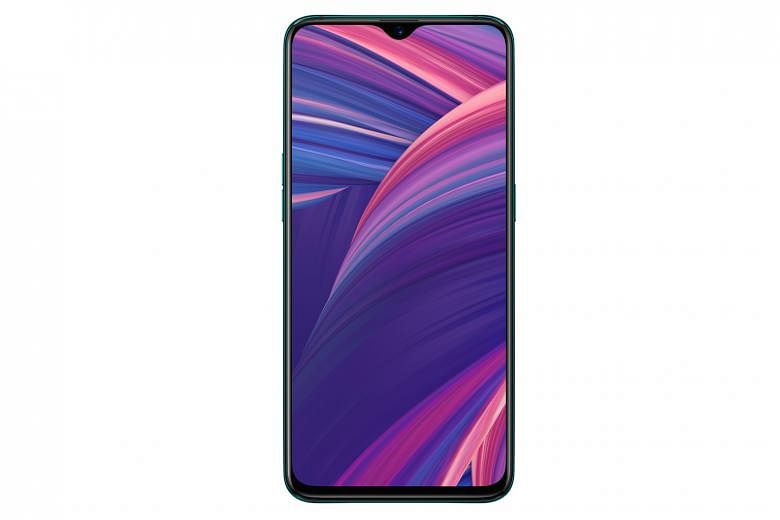Oppo's new R17 Pro smartphone is a bit of an oddball. It boasts some of the latest innovations in the industry, such as an in-display fingerprint sensor and a super-fast charging feature.
Yet its processor is an upper mid-tier Qualcomm Snapdragon 710 chip that slots between the flagship Snapdragon 845 and the mid-range Snapdragon 670.
Other typical flagship smartphone features - wireless charging and waterproofing - are also omitted in the R17 Pro.
Its $999 asking price for 8GB of memory and 128GB of internal storage (no support for expandable storage) also falls in-between flagship and mid-range smartphone prices.
Its unusual blend of features may make sense, given that Oppo is owned by BBK Electronics, which is also responsible for the Vivo and OnePlus brands. Perhaps Oppo is targeting a specific mix of features that would not compete with its sibling brands.
In any case, BBK has no qualms about re-using designs because the R17 Pro is a dead ringer for the OnePlus 6T that I reviewed recently.
Both smartphones have a near-identical all-screen design fronted by a vibrant 6.4-inch Oled screen.
-
SPECS
PRICE: $999
PROCESSOR: Qualcomm Snapdragon 710 (Dual-core 2.2GHz, hexa-core 1.7GHz)
DISPLAY: 6.4-inch, Amoled, 2,340 x 1,080 pixels, 402 ppi pixel density
OPERATING SYSTEM: ColorOS 5.2 (Android 8.1)
MEMORY: 128GB, 8GB RAM
REAR CAMERA: 12MP (f/1.5 or f/2.4), 20MP (f/2.6) and time-of-flight 3-D camera
FRONT CAMERA: 25MP (f/2.0)
BATTERY: Two non-removable 1,850mAh batteries
-
RATING
FEATURES: 4/5
DESIGN: 4/5
PERFORMANCE: 4/5
VALUE FOR MONEY: 3/5
BATTERY LIFE: 4/5
OVERALL: 4/5
Identical, too, is the teardrop-shaped screen notch for the front camera. This design helps the R17 Pro achieve one of the best screen-to-body ratios (around 86 per cent) in the market.
Their glass backs differ, though. The R17 Pro has a multi-hue gradient finish that is on-trend.
The effect is striking - my Emerald Green review set looks as if it has curved bands of light trapped in its glass back.
Even more eye-catching is the purple and blue Radiant Mist colour option, which reminds me of the Huawei P20 Pro, but with a matt finish instead of glossy.
The R17 Pro's standout feature is the incredible charging speed. In just 10 minutes of charging, its battery indicator jumped from 32 to 69 per cent. An additional 10 minutes brought it to 96 per cent. It basically takes around 30 minutes to fully charge the R17 Pro. At this speed, I do not miss wireless charging at all.
Apparently, its super-fast charging is because of a dual battery design. The catch is that you get this fast charging speed only with the bundled charger, which delivers more power than the standard charger. With a normal charger, the R17 Pro's battery was only at 50 per cent after an hour.
Its two batteries add up to offer 3,700mAh in capacity. The phone lasts around 12 hours in a video-loop test, which is in the same ballpark as the OnePlus 6T.
The R17 Pro has an in-display fingerprint sensor. An illuminated circle indicates where you should place your finger on the Oled screen to unlock the phone. However, the R17 Pro's fingerprint sensor feels slightly slower and less accurate than the OnePlus 6T's.
As a result, I mostly used the facial recognition feature to unlock the R17 Pro. But it does not work in the dark as the front camera lacks the necessary infrared camera component.
The front camera's Beauty mode, though, offers many ways to make you look better, including options to shrink your nose and make your eyes look bigger.
With its "Seize the night" tagline, it is clear that Oppo is confident of the R17 Pro's night photography chops.
Its main 12-megapixel camera has a dual aperture capability that, like Samsung's flagship phones, toggles automatically between f/1.5 and f/2.4 settings, depending on the surroundings. The lower aperture setting lets in more light, which should improve photos taken in poor light.
In my testing, the R17 Pro produces usable photos in low-light that are better than most smartphones. But the bar has been raised since Google unveiled its Night Sight feature this month.
The difference between both is day and night - the R17 Pro's night shots look much darker than the ones by a Pixel 3 with Night Sight mode. The former's images also exhibit more noise.
In well-lit conditions, the R17 Pro takes crisp and well-balanced photos that keep up with those taken by flagship models.
Its Portrait mode works well most of the time, thanks to a secondary rear camera. But there were instances where the camera incorrectly delineated the edges of the subject while trying to blur the background for the bokeh effect.
In addition to its two rear cameras, the R17 Pro has a time-of-flight camera that is used to capture 3D images and act as a rangefinder. But I was unable to test it as the feature will not be ready till next month with a software update.
Oppo says one of the first uses of this camera is an augmented reality tape measure app that can estimate distances in the real world, which is presumably similar to the MeasureKit app for Apple's iOS devices.
Like many Chinese smartphones, the ColorOS skin on the R17 Pro is influenced by Apple's iOS. It is slightly disappointing that it is still using Android 8.1 and not the latest Android 9.0 like the OnePlus 6T.
ColorOS has a handy Smart Sidebar with customisable shortcuts to apps and other tools that is accessible with a swipe from the edge of the screen, even when you are using another app in full-screen mode.
• Verdict: The R17 Pro stands out with its amazing fast-charging feature, though its in-display fingerprint sensor is not as polished.


